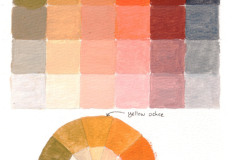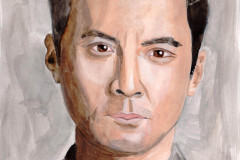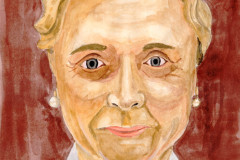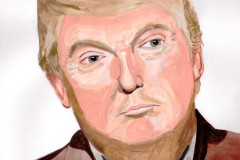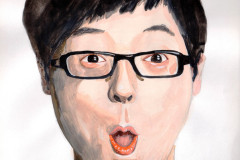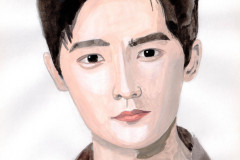Introduction
Gouache paint offers artists a unique way to create vibrant and opaque colors. Unlike transparent watercolors, gouache provides a solid finish that covers surfaces with deep tones and light-reflective qualities. Its versatility allows for quick layers and corrections, making it an excellent choice for mixed media artworks on canvas. Mixed media combines various materials and techniques, allowing your creativity to flow freely. When you bring gouache together with other media, you can build texture and layers that captivate the eye.
This article helps you discover how to make the most of gouache paint when working on canvas using mixed media. You’ll learn practical steps to blend gouache with other materials like paper, fabric, and found objects. The process highlights how gouache’s opacity and matte finish enable new styles and techniques. Whether you are a beginner or want fresh ideas, these insights encourage you to experiment and transform your canvas into unique art pieces.
Understanding Gouache Paint Properties
Gouache paint holds unique qualities that make it ideal for mixed media art on canvas. Its opaque nature allows you to cover previous layers completely, unlike watercolor which is transparent. This opacity helps you build strong, vibrant areas of color without worrying about the background showing through.
The drying time of gouache is relatively quick, usually within 15 minutes, letting you add layers faster. Its finish is matte, which reduces glare and creates a flat surface that works well with other materials like pencil, ink, or collage elements. You can rewet dried gouache to soften edges or blend colors, a feature acrylics don’t offer easily.
Understanding these properties lets you plan layering and mixed media combinations better. How can you use gouache’s matte finish to contrast with glossy elements? Could its opacity help mask textures underneath? Considering these questions will help you innovate in your mixed media projects.
What is Gouache Paint Made Of
Gouache paint consists mainly of natural pigments that give it strong, rich color. These pigments suspend in a binder called gum arabic, which holds the paint together and helps it stick to surfaces. This binder also allows you to rewet the paint even after it dries, which can be useful for blending or corrections.
Fillers like chalk or inert white particles are part of the formula too. These fillers contribute to gouache’s thickness and opacity, making the paint cover well on various surfaces including canvas. Because of these ingredients, gouache can create opaque, matte layers that contrast well with transparent media like watercolor or shiny acrylic paints.
Knowing what’s inside your paint helps you predict how it behaves when combined with other media. How might the chalk fillers affect the texture when applied thickly? Could the gum arabic influence how adhesives work on your canvas? These insights help you manage your paint for mixed media work.
How Gouache Behaves on Canvas
When applied to canvas, gouache dries quickly and forms a solid matte layer. This quick drying lets you build layers without long waits. Its opacity means you can paint over previous layers without them showing through.
The matte finish creates a surface that doesn’t reflect much light. This quality helps other materials like ink or graphite stand out sharply on top. Because gouache reactivates with water, you can soften edges or blend colors during or after the painting process, giving you flexibility.
This behavior opens up options for layering different media. You might paint opaque shapes with gouache, then add fine details using markers or pencil over the matte surface. How well will your next layer stick? Will rewetting affect earlier elements? Thinking about these questions ensures your mixed media canvas holds together beautifully.
Selecting the Right Canvas for Mixed Media
Canvas Types and Textures
Canvas comes in several fabric options, each affecting how your gouache and mixed media materials interact. Cotton canvas is common and affordable. It offers a smooth surface that works well for detailed brushwork, but it can absorb moisture quickly.
Linen canvas, on the other hand, has a tighter weave and stronger fiber. It gives you a more textured surface, which can add depth to your mixed media work. Linen holds up better to heavy layers but costs more.
Duck canvas features a looser, heavier weave. Its texture is rougher, adding natural grip for your gouache. Artists often choose duck when planning to build thick mixed media layers or add collage elements because it provides sturdy support.
Consider how texture influences paint adhesion. A rougher canvas grips paint better but can change brushstroke behavior. Fine weaves allow smoother blends but pick up less pigment. What surface will best suit your artistic moves and layering style?
Preparing Canvas for Gouache and Mixed Media
Raw canvas usually needs priming before you add gouache and mixed media. Gesso is the most common primer and creates a white, sealed surface that prevents paint from soaking in. Applying two or three thin coats of acrylic gesso gives you a reliable ground for your layers.
You can customize gesso by sanding between coats for extra smoothness or adding texture by stippling it on. For alternative primers, clear flexible mediums can preserve the fabric’s natural color while still sealing.
Preparing the surface properly strengthens adhesion and protects the canvas from warping or moisture damage. Have you tried layering your gesso with texture? Think about your media choices—will your canvas receive heavy materials? Prime accordingly to avoid peeling or cracking later.
Starting Your Mixed Media Canvas Project
Careful planning is key to a successful mixed media canvas project with gouache. Begin by thinking about your main idea and what story you want your artwork to tell. Sketch lightly on your canvas with a pencil or charcoal. This will help you visualize where gouache will shine and where other materials will add texture or dimension.
Plan your layers so the paint and materials interact without smudging or lifting each other. Gouache dries quickly but can reactivate with water, so decide where you want thick, opaque strokes versus thin, transparent washes. Organize your steps to apply gouache before or after layering other media, depending on how they blend.
Think about how different textures will work together. Planning ahead saves frustration and helps you build the piece step-by-step. What mood do you want your composition to express through colors and textures? That question can guide many choices before you start applying paint.
Planning Your Composition
Start with a simple outline that includes the main shapes and areas where gouache will be applied. Use a light pencil or pastel sketch so it won’t interfere with your paint layers. Decide which parts need sharp edges and which benefit from blending.
Consider how gouache’s matte finish will look beside glossy or textured materials. For example, plot where you might add a torn paper edge or stitched fabric. The sketch can serve as a map to keep your artwork balanced and cohesive.
Ask yourself what parts should pop with bold color and which should remain subtle. In your sketch, mark these zones clearly. This keeps your gouache layers efficient and supports the mixed media effect rather than competing with it.
Choosing Materials to Combine
Select materials that complement gouache’s properties on canvas. Lightweight papers like rice paper or tissue add delicate texture without overwhelming the paint. Rougher handmade papers can create bold contrasts with smooth gouache strokes.
Fabrics such as canvas scraps or lace provide depth and interest. Attach them with glue or gel mediums that dry clear to keep focus on your paint details. Found objects like metal pieces or thread can bring unique shapes but test their adhesion first.
Choose materials that allow gouache to sit on top or blend smoothly. Avoid oily or highly absorbent surfaces that disrupt paint layers. Are you aiming for a soft, blended look or sharp, graphic contrasts? Your material choices will support this vision throughout your project.
Techniques for Applying Gouache on Canvas
Brush Techniques and Coverage
You can create many effects with different brush strokes when working with gouache on canvas. Using a flat brush applies smooth, even layers that fully cover the surface. This method helps when you want bright, solid areas of color. A dry brush can add texture by creating scratchy, broken strokes that reveal the canvas beneath. Try stippling with a round brush for dot patterns that build texture and depth.
Remember, gouache is thicker than watercolor but thinner than acrylic. You can control coverage by adjusting water amounts. Thicker paint offers opaque coverage, while more water makes it slightly transparent. Testing brush strokes on a scrap canvas first helps you see how much paint you need. What new effect could you achieve by mixing thick and thin strokes on one area?
Layering and Correcting Mistakes
You can layer gouache on canvas by waiting until the first layer fully dries. Use thin layers to avoid cracking. Adding paint gently on top prevents disturbing the base layer. If you see errors, wait for the paint to dry before fixing them. Scrape unwanted marks lightly with a damp brush or a clean cloth. This method works better than wet scrubbing, which can damage previous layers.
To correct colors, paint a thin, opaque layer over the mistake. Because gouache dries matte, each new layer blends well without mixing unintentionally. Have you considered turning a mistake into a new feature by layering creatively? Using layering not only fixes errors but can enrich your composition with depth and color variation.
Incorporating Mixed Media Elements
Integrating other media with gouache on canvas can add texture and visual depth to your art. Use strong adhesives like acrylic gel medium or heavy-duty PVA glue to attach materials securely. Test each adhesive on a small area to ensure it doesn’t cause damage or bleed through the gouache layers.
Layering plays a key role when combining materials. Apply paper, fabric, or small objects between gouache layers and seal them with a clear medium to keep the surface stable. This approach prevents peeling and helps your artwork last longer.
Check compatibility before combining materials. Avoid water-soluble media like watercolor on top of gouache since it might reactivate the paint. Instead, consider using permanent inks, acrylics, or collage elements that hold up well with gouache’s matte finish.
Adding Textures and Materials
Attach fabrics, papers, and objects with adhesives that dry clear and flexible. Acrylic mediums work well for heavier items, while glue sticks or spray adhesives suit delicate papers. Press materials firmly and let them dry completely before painting over.
Thin fabrics like lace or gauze create subtle texture, while burlap or canvas patches add bold dimension. Consider layering different textures for contrast. You can sew or staple objects too, but secure them tightly to avoid damage when transporting your artwork.
Try embedding found objects like buttons, thread, or small trinkets. Keep scale and weight in mind so these additions do not overwhelm your canvas or cause it to warp.
Blending Media Seamlessly
To unify gouache with other materials, use layering and color adjustments. Paint over edges of fabrics or papers to blend them into your composition. This helps hide harsh lines and creates a cohesive look.
Experiment with transparent glazes or thin gouache washes to soften transitions between media. These layers can tone down bright pieces and tie them into your overall color scheme.
Consider light sanding or gently scratching raised edges after drying to give subtle texture shifts between materials. Use consistent brushstrokes across different surfaces to maintain a connected feel.
Ask yourself: Does this combination add interest without distracting from my main subject? Blending thoughtfully ensures your mixed media canvas feels like one complete work, not a collection of separate parts.
Color and Composition Strategies
Working with Gouache Colors
Gouache paints have a unique opacity that sets them apart from other media on canvas. You can use this feature to either make colors pop or gently blend them with other materials.
Try pairing gouache’s flat, matte finish with shiny or textured materials like foil or fabric. This contrast draws the eye and creates depth in your piece.
Think about whether you want your gouache colors to complement surrounding elements or stand in sharp contrast. For example, soft pastels can balance rough paper textures, while bold reds or blues can dominate a muted background.
Ask yourself: Should the gouache be the focal point, or act as a supporting color? Experiment with layering thin washes to add subtle color shifts without overpowering mixed media elements.
Composing for Mixed Media
When you work with mixed media, arranging colors, shapes, and textures is key to creating harmony. Instead of random placement, plan your composition thoughtfully.
Use color to guide viewers through your work. Group similar hues to create calm areas. Place contrasting colors next to each other to add energy and movement.
Consider size and shape too. Large, simple gouache shapes can balance tiny, detailed bits of collage or ink lines.
How do you want the eye to travel across the canvas? Try sketching a loose layout first. This step helps you test how different colors and textures play together before committing.
Balance dense, textured spots with open, painted areas. Let each part of your mixed media piece breathe to prevent visual clutter.
Protecting and Finishing Your Gouache Mixed Media Art
Gouache combined with varied materials on canvas needs careful protection to last. When sealing your work, choose varnishes that suit the sensitivity of gouache paint and other mixed media elements. Matte or satin varnishes work well because they don’t add unwanted shine while protecting your colors and textures.
Consider spray varnishes designed for delicate surfaces. They apply evenly and avoid disturbing fragile paint layers. Test sprays on a small section before applying to the entire canvas. Some artists find that a light coat of fixative before varnishing adds an extra layer of security and helps prevent smudging.
Protecting your art does not stop at sealing. Proper framing can guard against dust, light, and physical damage. Opt for frames with UV-protective glass or acrylic. This blocks harmful rays that might dull your colors over time. Make sure there is space between the artwork and glass to avoid sticking or pressure on the surface.
Your storage choices also affect preservation. Store canvases upright in a dry, cool area away from direct sunlight. Avoid stacking artworks to prevent pressure marks or deformation. Using acid-free materials or covers can reduce risk from environmental factors. Do you know where your art will live when not on display? Taking these steps helps your mixed media creations stay vibrant and intact for years.
Creative Project Ideas with Gouache and Mixed Media
Using gouache in mixed media opens many paths for your creativity on canvas. You might try layering thick gouache over textured surfaces like modeling paste or fabric to add depth. Mixing gouache with materials such as paper scraps, sand, or wire gives your piece a tactile feel and invites viewers to explore it closely. Think about applying bold color blocks, then scratching or rubbing parts away to reveal layers underneath. This technique creates an engaging play between color and texture.
Try combining gouache with collage elements or ink lines to build contrast. Using gouache’s matte finish alongside glossy mediums can bring out interesting visual effects. What materials nearby could you include to challenge your usual process? Experiment with unexpected tools like sponges or palette knives for applying gouache to add fresh marks and textures. Each attempt will teach you how gouache behaves with different media, encouraging you to push your style further.
Abstract and Textured Pieces
Abstract works thrive when you focus on color shifts and surface texture. Lay down thick patches of gouache in irregular shapes, then layer sand or fabric scraps on top. You can scrape or brush over dried layers to reveal colors below. Use contrasting tones and shapes to keep your eye moving across the canvas.
Try building a series exploring one texture per piece. For example, one canvas might combine rough sand and gouache, while another uses soft cloth and paint layers. This approach pushes you to think about the tactile qualities gouache brings. What new textures could challenge you as an abstract artist today? Your hands and eyes will discover new ways to balance color and form without relying on recognizable images.
Figurative and Detailed Works
Gouache shines when you combine crisp painting with mixed media accents in figurative art. Start with a precise gouache portrait, then add layers of thin paper or thread to enhance clothing or hair. Use gouache’s opacity to correct or intensify details throughout the piece.
Experiment with adding pencil or charcoal lines over dried gouache to bring depth. Small glued objects like beads or metal charms can highlight accessories, adding dimension. When creating figures, does manipulating texture around the subject help the form stand out? Focus on balancing fine brushwork and tactile elements to boost realism while embracing mixed media’s freedom. This method takes your detailed works beyond flat paint, inviting viewers to linger.
Troubleshooting Common Challenges
Managing Paint Cracks and Peeling
Cracks and peeling in gouache on canvas usually happen when the paint dries too quickly or the surface isn’t prepared properly. Gouache forms a matte, brittle layer that can crack if you apply thick coats or paint over it while it’s still damp. Using heavy layers can cause the paint to shrink and pull away from the canvas, especially with mixed media layers underneath.
Start by applying thin layers of gouache, letting each dry fully before adding more. Avoid heavy-bodied gouache or mixing it with too much water. When you build layers, wait until each is dry before adding texture or collage elements. Preparing your canvas with an acrylic gesso primer creates a smoother foundation and improves paint adhesion.
If you see peeling, you can gently press the paint back down with a flat brush or palette knife once it is dry but fragile. Fix weak spots by lightly sanding the area before repainting thin layers. Have you noticed any certain materials that cause more peeling? Keeping your layers balanced helps prevent these problems.
Ensuring Material Adhesion
Securing mixed media parts without harming your gouache layer takes planning. Some adhesives contain solvents that might dissolve or smudge gouache, especially if the paint is still fresh. Using the wrong glue can lift or damage painted surfaces.
Test adhesives on a small painted canvas piece before proceeding. Use glue types like matte medium or PVA glue, which work well with gouache and won’t harm the paint. Apply adhesives carefully and avoid spreading glue over large painted areas.
When attaching heavy objects like fabric or paper, press them firmly but gently so you don’t crack the paint beneath. Adding a fixative spray designed for gouache after your painting fully dries can help seal layers and improve adhesion. How do you balance your mixed media components while protecting delicate paint layers? Careful layering and adhesive choice make a big difference.
Conclusions
Using gouache paint in mixed media on canvas opens many possibilities for creative expression. Its quick drying time and solid coverage let you add layers without waiting long. Combining gouache with other textures or materials enhances your artwork and brings it to life in new ways. Consider how the paint’s opacity suits different effects and how its finish impacts color choices. Your ability to adjust and adapt with gouache makes your process more flexible and enjoyable.
You now have ideas on how to start or enhance your gouache mixed media projects on canvas. Keep exploring different combinations and methods to find what suits your style. Remember, mixing materials and techniques lets you tell your story visually and inventively. Use gouache’s qualities to guide your choices and create distinct, personal art. How will you bring your next canvas to life with these fresh ideas?



















